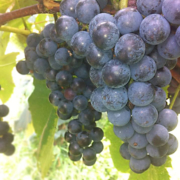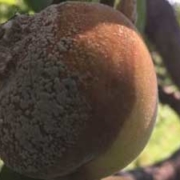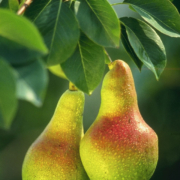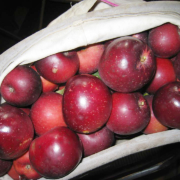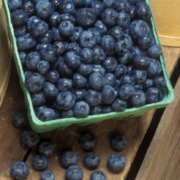Grapes in High Tunnels Can Greatly Reduce Pesticide Use and Increase Yields
 Print This Post
Print This Post
By Guy K. Ames, NCAT Horticulture Specialist
A new collection of six ATTRA publications and three videos provides growers with a comprehensive, step-by-step explanation of how to grow table grapes in high tunnels. This approach to grape growing can produce high yields of high-quality grapes while greatly reducing pesticide use (relative to conventional field production).
As a young, would-be organic farmer in the early 1970s, I drooled over the nursery catalog photographs of plump, succulent bunches of grapes as if they were the very essence and promise of good farming and good health. The genus containing grapes is Vitis, a word from the proto-Indo-European root, which means “living or life itself.” Wow. Grapes=life itself!
But for decades my desire for that organically grown, vinous abundance was thwarted. I initially failed to understand that the modern seedless grape that dominates the marketplace is ill-adapted to organic methods, especially outside California and similar arid environments. Our modern food system has chosen and bred for grapes with good shipping characteristics, high productivity, seedlessness, and appeal to the most consumers. If you want to fit into this market paradigm and live outside the usual arid grape production areas, up until now you’ve had essentially one option: pesticide sprays and lots of them.
Wetter environments, like practically all of the eastern United States, foster several serious grape diseases. Of the 60 species in the genus Vitis, the dozen or so native to our area are adapted to this wet climate but don’t have the other characteristics the marketplace demands. There are a few named varieties of grapes (e.g., ‘Concord’ and ‘Catawba’) that can be grown here with well-timed sprays of sulfur and copper fungicides, and there are even more varieties of grapes that can be grown with modern synthetic fungicides. But for the committed organic grower who preferred no fungicides at all, choices were few (and none of those, by the way, were seedless).
Now there is another option: high tunnels. To understand why this is such a game changer, you need to understand that all of the grape pathogens, with the exception of the fungus that incites powdery mildew, need free water (rain or dew heavy enough to form droplets) on the fruit and foliar surfaces to spread, infect, and reproduce. In the absence of free water, there are virtually no diseases, and certainly none of the diseases like black rot that can destroy whole crops. Keep the rain off or move to California, and you have the potential for organic grapes!
The University of Arkansas’ grape research team, led by Dr. Elena Garcia, started experimenting with growing grapes in high tunnels in 2014. Inspired by seeing the benefits of growing blackberries and raspberries in high tunnels, she planted some of the university’s grape cultivars (‘Faith’, ‘Jupiter’, and ‘Gratitude’) in a 180-foot by 25-foot-high tunnel at the University of Arkansas System in Fayetteville. In Arkansas’s climate, first harvests don’t come until the second or third year after planting. But these grape vines grew so vigorously in the tunnel that they bore fruit after just one season.!
In fact, it was almost too much of a good thing. The vines and fruit grew so strong and heavy that they strained the trellis system, and it became necessary to do extra leaf pruning and fruit cluster thinning. And the foliage and fruit were beautiful! I’ve grown grapes at the hobby level for years and, as a graduate student, participated in the University of Arkansas’s world-renowned grape breeding program begun by Dr. James Moore in the 1970s. I have never seen cleaner, more vigorous and healthier vines and fruit than I saw in the University’s high tunnel trials.
Though the university research team is reluctant to say outright that grapes could be grown organically in such a high tunnel system, the possibility seems tantalizing real to me. Some black rot and insect damage can be found on the high-tunnel grapes, but compared to grapes grown outside a high tunnel, the damage is miniscule. At the very least, the pesticides that the research team did employ for insects and disease were a small fraction of what is necessary to bring in a marketable crop in conventional, field-grown grapes in Arkansas.
NCAT Horticulture Specialist and former UA horticulture graduate student Luke Freeman initiated a joint NCAT/University of Arkansas project to produce a series of six publications and three videos about high tunnel grape production. The publications cover everything from siting the high tunnel to economics of the system—which proved to be profitable even with the cost of the tunnel and the extra management requirements.
To be clear, high tunnel production might not be for every would-be grape grower, as it has its own particular imperatives. Furthermore, nothing about the high tunnel system will preclude the grower from knowing all the basics of grape growing, and there is a lot to know. Finally, though the possibility is there, certified organic grape production has yet to be demonstrated.
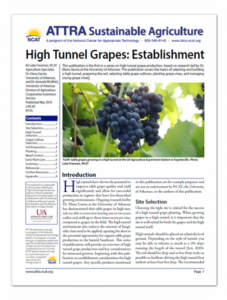 Check out all the titles in this new series:
Check out all the titles in this new series:
Publications
High Tunnel Grapes: Establishment
High Tunnel Grapes: Pruning, Trellising, and Training
High Tunnel Grapes: Temperature and Soil Management
High Tunnel Grapes: Pest Management
High Tunnel Grapes: Harvest and Quality Considerations
High Tunnel Grape Production: An Economic Analysis
Videos
High Tunnel Grapes: Cluster Thinning
High Tunnel Grapes: Winter Pruning
High Tunnel Grapes: Trellising and Training
This blog is produced by the National Center for Appropriate Technology through the ATTRA Sustainable Agriculture program, under a cooperative agreement with USDA Rural Development. ATTRA.NCAT.ORG.

